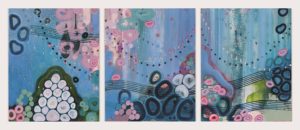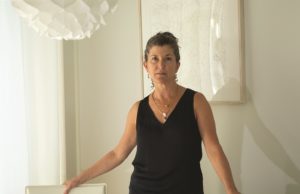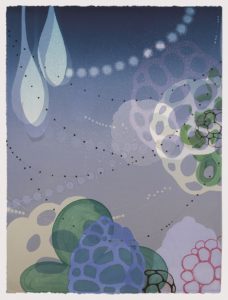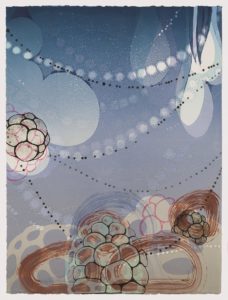Sarah Lutz’s art elicits a rare response in the viewer, who not only enjoys looking at the paintings, but thinks that it might be enjoyable to meet the artist herself. When the artist and her art are in the same space, one notices a resemblance not unlike family members. They don’t contain a shred of angst or hate, melancholy or pessimism. Recurring shapes drift along in a peaceful world of what Schoolhouse Gallery Director Mike Carroll describes as a “gentle jostling of forms” caught mid-resolution — some at the top and middle of the frame, others pulled gently to the bottom as if by gravity.

These shapes, forms, and lines have often been compared to zygotes, doughnuts, seaweed, and geodes. Lutz’s canvases have also been compared to underwater worlds — probably because of their prominent blues and greens, and their translucent nature. But this comparison would be a mistake. These are not abstracted images of objects in our reality, but rather objects unto themselves, formed over time in Lutz’s imagination.

“The forms are not intended to be something,” Lutz says. “They’re open to the viewer.” They compose a private, consistent visual language, allowing for a real dialogue between artist and viewer.
Lutz has been summering in Truro for almost 40 years. She was born in Madison, Wisc. and, having lived most of her childhood in Vermont and Guatemala, she now divides her time between Truro and upstate New York, where she recently moved after 25 years in New York’s West Village.
Painting, studying, and honing her craft have been never-ending pursuits for Lutz. During her first summer here as a teenager, she took workshops at Truro Center for the Arts at Castle Hill (where she now serves on the board). She later earned fine arts degrees from Skidmore College and American University and spread her roots deeply through the Cape artistic community — first at a women’s cooperative artists’ group and the now vanished DNA Gallery, then as a founding member of artSTRAND, also defunct.

She finally found a home at Schoolhouse Gallery, where she’s been represented since 2013. A show of her paintings, prints, and small works is currently on view there — a testament to a mature artist working at the top of her game.
It’s apparent that Lutz and Carroll not only respect each other’s work, they also enjoy one another’s company. Meeting at Carroll’s house (as that was where Lutz’s work was stored before the show), they greet each other with hugs, squeals, kisses, and a bottle of white wine. “Not many painters use joy in their toolbox,” Carroll notes. “Each of her paintings is a synthesis of joy and feminine strength.”

Lutz is not interested in making representational art. “What I really love is the dichotomy that can exist in a painting — the way paint can make things look flat and two-dimensional, and also create an illusion of deep atmospheric space,” she says. “It’s most interesting when you have moments when both are happening in the same painting because they accentuate each other.
“Another dichotomy I find compelling is geometric and organic forms co-existing,” she continues. “There are so many forms of nature that mimic the idea of rounded, organic forms made up of multiples in a geometric way.” She cites the veins in a leaf, a nautilus shell, and a dried poppy seed casing as examples.

Action and motion are constants in Lutz’s work, resulting from the artist’s ability to place and control the materials on her canvases. The eye never really stops as it follows shapes and lines through and around space. Carroll says that Lutz’s work reminds him of Paul Klee’s famous remark, “A line is a dot that went for a walk,” because “people become immediately involved in her works and are very glad to follow her hand through the various decisions she has made.”
Some of those decisions, however, are a bit intuitive. The sense of space in Lutz’s work is the result of “scraping unaccountable layers,” she says. “I don’t know the atmosphere until it’s there.”
Love and Lutz
The event: Works by Sarah Lutz, alongside ones by Jennifer Amadeo-Holl, Jeannie Motherwell, Ted Kincaid, and Anna Poor
The time: Through Aug. 11; open daily, 11 a.m. to 5 p.m.; Thursday through Sunday, until 8 p.m.
The place: Schoolhouse Gallery, 494 Commercial St., Provincetown
The cost: Free
